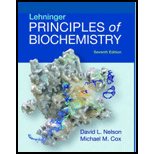
Concept explainers
(a)
To determine: The structural aspect of the 18-carbon fatty acids can be correlated to the melting point
Introduction:
Fatty acids are a class of lipids. They are non-polar compound this means they can only dissolve in non-polar solvents such as benzene, diethyl ether, and hexane. Fatty acids can be saturated or unsaturated. Saturated fatty acids are those which do no possess any double bond in its structure, For example: Palmitic acid and stearic acid. While unsaturated fatty acids possess one or more double bonds, For example: Oleic acid and linoleic acid.
(b)
To draw: The possible triacyglycerols that can be constructed from glycerol, palmitic acid, and oleic acid, and also rank them in order of increasing melting point.
Introduction:
Fatty acids are a class of lipids. They are non-polar compound this means they can only dissolve in non-polar solvents such as benzene, diethyl ether, and hexane. Fatty acids can be saturated or unsaturated. Saturated fatty acids are those which do no possess any double bond in its structure, For example: Palmitic acid and stearic acid. While unsaturated fatty acids possess one or more double bonds, For example: Oleic acid and linoleic acid.
(c)
To determine: The presence or absence of branched-chain fatty acid increase or decrease the fluidity of the membrane.
Introduction:
Fatty acids are a class of lipids. They are non-polar compound this means they can only dissolve in non-polar solvents such as benzene, diethyl ether, and hexane. Fatty acids can be saturated or unsaturated. Saturated fatty acids are those which do no possess any double bond in its structure, For example: Palmitic acid and stearic acid. While unsaturated fatty acids possess one or more double bonds, For example: Oleic acid and linoleic acid.
Want to see the full answer?
Check out a sample textbook solution
Chapter 10 Solutions
Lehninger Principles of Biochemistry
- The following data were recorded for the enzyme catalyzed conversion of S -> P Question: what would the rate be at 5.0 x 10-5 M [S] and the enzyme concentration was doubled? Also, the rate given in the table is from product accumulation after 10 minuets of reaction time. Verify these rates represent a true initial rate (less than 5% turnover). Please helparrow_forwardThe following data was obtained on isocitrate lyase from an algal species. Identify the reaction catalyzed by this enzyme, deduce the KM and Vmax , and determine the nature of the inhibition by oxaloacetate. Please helparrow_forwardIn the table below, there are sketches of four crystals made of positively-charged cations and negatively-charged anions. Rank these crystals in decreasing order of stability (or equivalently increasing order of energy). That is, select "1" below the most stable (lowest energy) crystal. Select "2" below the next most stable (next lowest energy) crystal, and so forth. A B 鹽 (Choose one) +2 C +2 +2 (Choose one) D 鹽雞 (Choose one) (Choose one)arrow_forward
- 1. Draw the structures for the fats A. 16:2: w-3 and B. 18:3:49,12,15 2. Name each of the molecules below (image attached)arrow_forwarddraw the structures for the fats A. 16:2:w-3 B 18:3:9,12,15arrow_forward1. Below is a template strand of DNA. Show the mRNA and protein that would result. label the ends of the molecules ( refer to attached image)arrow_forward
- Attach the followina labels to the diagram below: helicase, single stranded binding proteins, lagging strand, leading strand, DNA polymerase, primase, 5' ends (3), 3' ends (3) (image attached)arrow_forward1. How much energy in terms of ATP can be obtained from tristearin (stearate is 18:0) Show steps pleasearrow_forwardMultiple choice urgent!!arrow_forward
 BiochemistryBiochemistryISBN:9781319114671Author:Lubert Stryer, Jeremy M. Berg, John L. Tymoczko, Gregory J. Gatto Jr.Publisher:W. H. Freeman
BiochemistryBiochemistryISBN:9781319114671Author:Lubert Stryer, Jeremy M. Berg, John L. Tymoczko, Gregory J. Gatto Jr.Publisher:W. H. Freeman Lehninger Principles of BiochemistryBiochemistryISBN:9781464126116Author:David L. Nelson, Michael M. CoxPublisher:W. H. Freeman
Lehninger Principles of BiochemistryBiochemistryISBN:9781464126116Author:David L. Nelson, Michael M. CoxPublisher:W. H. Freeman Fundamentals of Biochemistry: Life at the Molecul...BiochemistryISBN:9781118918401Author:Donald Voet, Judith G. Voet, Charlotte W. PrattPublisher:WILEY
Fundamentals of Biochemistry: Life at the Molecul...BiochemistryISBN:9781118918401Author:Donald Voet, Judith G. Voet, Charlotte W. PrattPublisher:WILEY BiochemistryBiochemistryISBN:9781305961135Author:Mary K. Campbell, Shawn O. Farrell, Owen M. McDougalPublisher:Cengage Learning
BiochemistryBiochemistryISBN:9781305961135Author:Mary K. Campbell, Shawn O. Farrell, Owen M. McDougalPublisher:Cengage Learning BiochemistryBiochemistryISBN:9781305577206Author:Reginald H. Garrett, Charles M. GrishamPublisher:Cengage Learning
BiochemistryBiochemistryISBN:9781305577206Author:Reginald H. Garrett, Charles M. GrishamPublisher:Cengage Learning Fundamentals of General, Organic, and Biological ...BiochemistryISBN:9780134015187Author:John E. McMurry, David S. Ballantine, Carl A. Hoeger, Virginia E. PetersonPublisher:PEARSON
Fundamentals of General, Organic, and Biological ...BiochemistryISBN:9780134015187Author:John E. McMurry, David S. Ballantine, Carl A. Hoeger, Virginia E. PetersonPublisher:PEARSON





